Rose Datoc Dall is a painter whose art has been recently featured in multiple books produced by LDS-affiliated publishers. Throughout her career, she has focused on a woman’s perspective in presenting scenes from the New Testament, particularly the life of the Savior and His mother, Mary.
When and how did you start painting?
I’ve been doing it all my life – I’ve always been inclined to drawing and painting. I was born in Washington DC and raised in Northern Virginia, and I got my degree in Fine Arts Studio and Art History from Virginia Commonwealth University School of the Arts in 1990.
Have you focused on art for the entirety of your career, or was it on the side while you did other things?
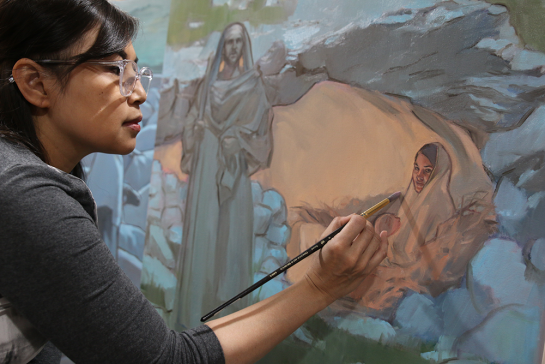
Rose Datoc Dall Painting
My husband and I got married when we were both seniors in college. He was at Utah State, so it was a long-distance relationship while I was going to school out in Virginia. (We’d been dating long distance for about a year prior to marriage). We then moved out to Utah because he was finishing at Utah State. Therefore, I took my last few remaining credits there. We started having kids very quickly; within 15 months of being married, we had our first child. The first two were close together, then the third and fourth all within five years. So I jumped into motherhood and was really just doing the mom thing. I was painting, but as you can imagine, not a lot, being a full-time mom. When my kids were infants, I had to cut myself some slack.
My kids are all grown now. It’s hard to believe all that time went by so fast. Our youngest is on a mission and the rest are all grown. Two are married and one engaged. My ability to make more time for painting increased as my kids got older. I’m doing art full-time now as an empty-nester.
What made you decide to focus on the scriptures and themes of faith in your art?
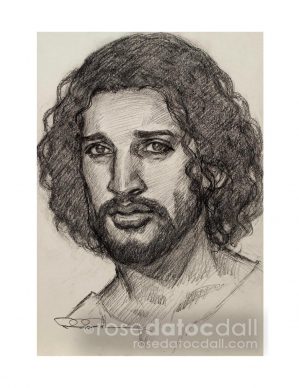
Drawing Study of Christ by Rose Datoc Dall
As a young mom, my artist friends were doing art shows and I was knee-deep in laundry and dirty diapers. I remember being so discouraged and I thought, “Well, maybe I’m not supposed to use my talent. Maybe I’d better put this on the altar because you know what…obviously things aren’t working here, and I’m kicking against the pricks. Maybe this dream of being an artist isn’t really what I should be doing.” So I took it to the Lord and got down on my knees.
It was, in a way, making a bargain, or maybe a covenant. I said, “If I am to continue to do art, then I will dedicate my work to the Lord.” To be honest, growing up not a member of the Church and going to an art school that was not a church school. I totally did not see myself doing religious art. Not a chance. I didn’t, at the time, see it as a relevant form of art. I dismissed it because a lot of religious art really didn’t interest me. It was illustration, and I didn’t think that was what I was about.
But then I prayed. I said, “If you want me to put my paints away, if you want me to just give this up and be a mom, okay. But just tell me. Because I’m tired of trying to make this work on my own. But if I did continue, I would dedicate it to the Lord”.
The answer that I got was really sweet: No, I didn’t need to put my paintbrushes away, but I did need to know that there are times and seasons to everything. My skill would keep – it’s like riding a bicycle in a lot of ways. Things would happen in their time. That was the answer. It was a wave of peace.
That’s good advice for young moms, and similar to what Sister Joy D. Jones said in the April 2020 General Conference – you don’t have to wear all the hats at the same time. Do you have thoughts for young moms who want to maintain their own interests and career while raising their children?
In hindsight, I look at myself when I was young and naïve, you think you can do everything. But then when you don’t perform, you kick yourself. I spun my wheels a lot just worrying, “My talents are going to dwindle and the world is passing me by.”
Furthermore, the second half of the answer to my prayer was really important: I should not compare my career nor my life to others, because that’s a downward spiral. Someone is always going to be better; someone is always going to be more accelerated in their career.
There’s always going to be somebody who is “making it.” I have since gone by that advice. I wish I could have told myself that earlier, but I think I had to go through that type of pain. I know what it’s like to be hungry but you can’t do anything about it.
Having said that, if you’re the sole breadwinner and you’re making your money doing art, that’s a different story. This is for those moms who feel like they’re having to put things aside to raise children.
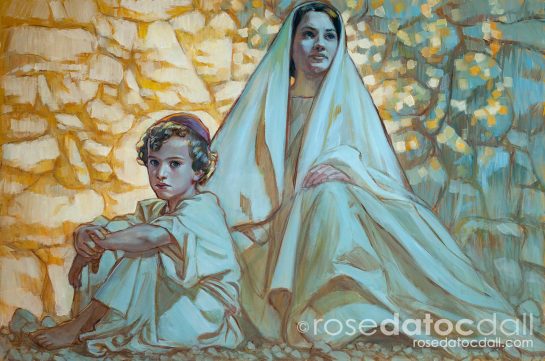
Young Son of Man and Mother by Rose Datoc Dall
My message to stay-at-home moms is that your life will ebb and flow, and follow your kids’ activities. There are going to be times when you can fit your personal interests and career plans into your life, and sometimes not. You’re also going to have different church callings, and other things thrown at you. For example, I have lupus, and there were a few years that I was in a lot of pain (we have since been able to figure out what was going on and manage it). I also had breast cancer. Things like that – interruptions happen. Also, big events in life happened – my two daughters got married. Therefore, you have to be willing to roll with the punches, be flexible, and be okay with that. If you’re going to be a mom, embrace it.
And what I’ve come to find is that being a mother has completely informed my art. My message to young moms is: you’re not missing out. Motherhood could potentially inform your art and make it even more powerful.
What did you do to continue to move forward with your art as you raised your children?
I always tried to do at least one group show per year. I was made aware that the Church has an International Art Competition every three years and I started entering it back in the 1990s. The first time I entered, I wasn’t accepted but every competition since, I have gotten in. It got me in this groove, and the Church started to take notice of me. I have since won three Purchase Awards through that exhibition – the Church History Museum started acquiring my art. Something clicked and I realized that I had something to say. I realized that I could bring my contemporary sensibilities to my religious art and I was able to create an intersection that made sense. Before, I had imagined myself in New York doing exhibitions, not doing religious art at all. I feel like the Lord has led me down a different path.
It was kind of hard to give that up and to shift. A lot of life is about making decisions and making some sacrifices. Even if people dismissed my art because I decided to focus on spiritual subjects (I didn’t know if I would lose respect in the art community), I’ve come to realize that if I’d tried to go in a more worldly direction, I don’t think I would have the success that I have now. Thus, I can only speculate.
But I do know that what has given my art power is my testimony. I can’t separate my religious self from my art. You have to infuse yourself into your art. My art would have come out spiritual anyway because that’s what I’m passionate about. Any art that matters needs to have a bit of you in it. It has to be authentic. And what I’ve come to find is that being a mother has completely informed my art.
Can you elaborate on how motherhood influenced your art so strongly?
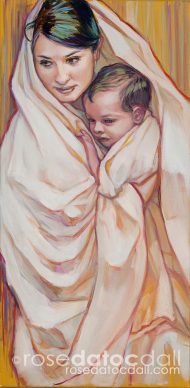
Mary and Child by Rose Datoc Dall
I’ve been drawing New Testament images of Christ for thirty years – in particular, I’ve been painting Mary for twenty of those years from a mother’s point of view during the early years of the Savior. These years are not even really described in the scriptures. I was imagining, and really fixated on the idea: what would it have been like to be Mary, to be the mother of the Savior? We look at it from the outside in, but I was trying to look at it from the inside out. She’s the one who had to deal with the boy Savior every day – changing His diapers and doing the ordinary work of raising this child. That was such a singular experience for her, and I tried to imagine that. The idea blew my mind. This whole painting series was from a woman’s point of view. Motherhood completely influenced my art because it was through the eyes of a mother that I painted this entire series, this long, long career of New Testament imagery. A lot of it isn’t just illustration, it is a personal commentary of a particular aspect or principle.
What do you mean by a personal commentary of a principle?
I’m not necessarily trying to teach a principle – it’s more like when I have a learning moment; that’s what I’m trying to paint. For instance, when I paint a New Testament scene – I did a painting called “What Lack I Yet?” – it’s Christ with the rich young man, mano a mano, two profiles of Christ and the rich young man, and he’s asking the Savior, “What lack I yet?” I’m projecting myself as the rich young man. In this painting, he hasn’t made the decision – he’s at a crossroads. I feel like I should be asking the Savior that question all the time. “What lack I yet? What do I need to be doing? What course correction is necessary?”
Another painting I did was just recently published in Hear Him, the new book with many depictions of Christ. The one I chose is called “Where Are Those, Thine Accusers?” and they asked me to write an excerpt for the book. It’s a painting of the adulterous woman. As I usually try to project myself, not that I see myself as an adulterous woman, it’s a painting about forgiveness. It’s not about, “Oh, I did this heinous thing” – it’s about forgiveness and self-forgiveness. I sometimes ask, “Why am I having a hard time forgiving myself when the Lord has already forgiven me?” Another message too is: it’s not about the nay-sayers. It’s really only between you and the Lord.
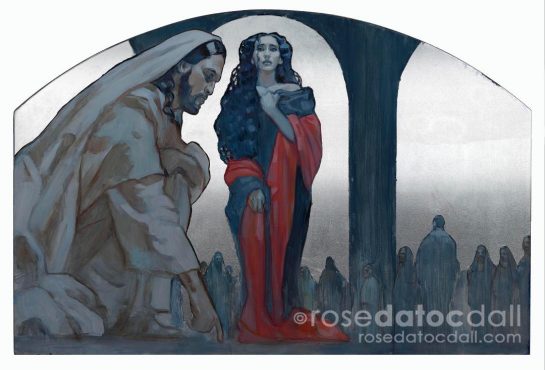
Where are Those Thine Accusers by Rose Datoc Dall
That is really beautiful.
Another painting I did is called “Living Waters” – the Church History Museum purchased that. It’s the Pool of Bethesda. In this painting, the paralytic man is centered in the foreground, reaching toward the water. Christ is approaching from behind, descending the stairs, and is lit with light. Though the painting is called “Living Waters,” it’s not really about the Pool of Bethesda – Christ is the Living Waters. It’s a reminder that we might be reaching for something, thinking this other thing is going to save us when we should be reaching for Christ.
I’m always, always projecting myself into the painting – that is my commentary.
Many paintings represent my “Ah-ha!” moments about a particular principle while listening to an awesome talk for example, and I think, “Oh wow, that blew my mind!” Some people journal about it. Well, I paint about it. A lot of my paintings are, in a way, like journal moments, the really cool “Ah-ha!” moments. That’s why I call them commentaries.
So your paintings have expanded beyond the early years of the Savior’s life into the adult years and His teachings.
I have a whole series of New Testament paintings that explored the adult years of the Savior’s life. I’ve actually depicted Christ from cradle to grave, and I’ve tried to consistently use the same model.
However, I switched model prototypes this year – you see, the world went a little crazy in 2020, and I suddenly had a shift in my racial awareness (along with the rest of the world): I had been painting Christ as an “icon” for thirty years, the “inherited icon,” a very recognizable white Jesus. I was not really aware, and I was just continuing this tradition that I’d inherited.
But it was this year (2020) that I started painting Christ with more Semitic features to honor his heritage. Changing was a hard choice because I thought, “Did I just make thirty years of my artwork obsolete?” I thought about it and you know what, I concluded, no it didn’t. That is still part of me. My earlier paintings are still part of my art. It’s part of my own personal story that I’ve made the switch. It was kind of risky to do it very abruptly, but I really felt like I needed to do it. Many of my Instagram followers were saying, “YES!” Not knowing how this would go, I thought I was going to lose followers. But the response I got was, “It’s about time.” Other artists said, “You’re giving us permission to do this too.”
I’m working on another painting right now – I heard a General Conference talk a couple of years ago about Christ turning the water into wine, and the point of that talk was that we are transformed, like the water was into wine when we consecrate ourselves. I wanted to translate that into a painting. I did some drawings and I think I posted the study on Instagram last year. That idea has been sitting around in my head and I’m going to paint “Water Into Wine” with the new Semitic depiction of Christ.
You have another painting – “Worlds Without Number” – that is not from the New Testament but is a depiction of Heavenly Father and Heavenly Mother. How did that one come to be?

Worlds Without Number by Rose Datoc Dall
I was asked to paint an image for McArthur Krishna’s book, A Boy’s Guide to Heavenly Mother. This painting was probably the most difficult painting I’ve ever painted to date. I’ve painted a lot of difficult things technically. This painting was both technically challenging and conceptually challenging. I started the painting as just a portrait of Heavenly Mother. Yet for some reason, I could not make it work. I then felt – “Ah-ha, now I know why it’s not working: it’s a partnership, and it needs to include Heavenly Father.” It was a struggle until I could really nail down what needed to be painted. This is what came out.
I had to be really careful because this is uncharted territory. My disclaimer is that this is my personal interpretation. I tried to stay doctrinal – I didn’t want to just go off on my own musings, so I was reading everything I could find. There’s not a lot – there’s more than I thought there was, but really, there’s not a lot. I didn’t want to go so far off into doctrine-according-to-Rose and get excommunicated for painting this. I went by what we learn in the temple. I tried to keep it consistent with what we know about that and the Abrahamic covenant, and what that means. That’s what this painting is about – the eternal – the worlds without number – that’s what we’re going to be doing – creating worlds without number in a partnership. That’s what the painting is all about.
I’ve seen a lot of people write about developing a relationship with Heavenly Mother, or Heavenly Parents – Them instead of just Him. Did creating this painting change anything for you?
It was the second time I was approached to do a project about Heavenly Mother. I didn’t really think about Her much until I started having more conversations with other women who are so passionate about the existence of Heavenly Mother. That was when I really started to think about it.
As I was working on the first project, the Church changed the Young Women theme during General Conference – I thought, “Oh my gosh! This is happening!” Then Elder Holland in the same conference referred to Heavenly Parents. I thought, “It’s about time!” I think one reason why nobody talked about it is because nobody really thought to talk about it. I was in that boat until there was more conversation. That got me really thinking and I started to realize: “Yes, how could it not be? How could there not be a Heavenly Mother?” With mentions in General Conference and the Young Women theme about Heavenly Parents, it also mentions them in the Family Proclamation, but it gets sort of easily overlooked.
I don’t know that I’ve actually communicated with Heavenly Mother. It’s not that I necessarily pray to Her. But I definitely feel more assurance of Her existence, and more of Her importance in the background.
The MWP has greatly benefited from the use of Rose Datoc Dall’s artwork on our website over the years. Thank you Rose for supporting the MWP and for sharing your talents with us.
At A Glance
Age: 52
Location: Lehi, Utah
Marital History: Married
Children: 4 (3 grandchildren, so far)
Occupation: Fine Artist (painter)
Convert to Church?: Convert, September 4, 1987
Education: BFA in Fine Art Studio & Art History
Languages Spoken at Hopme: English
Favorite Hymn: Come Thou Fount of Every Blessing
Website: rosedatocdall.com
Social: @rosedatocall
Interview Produced By: Trina Caudle
